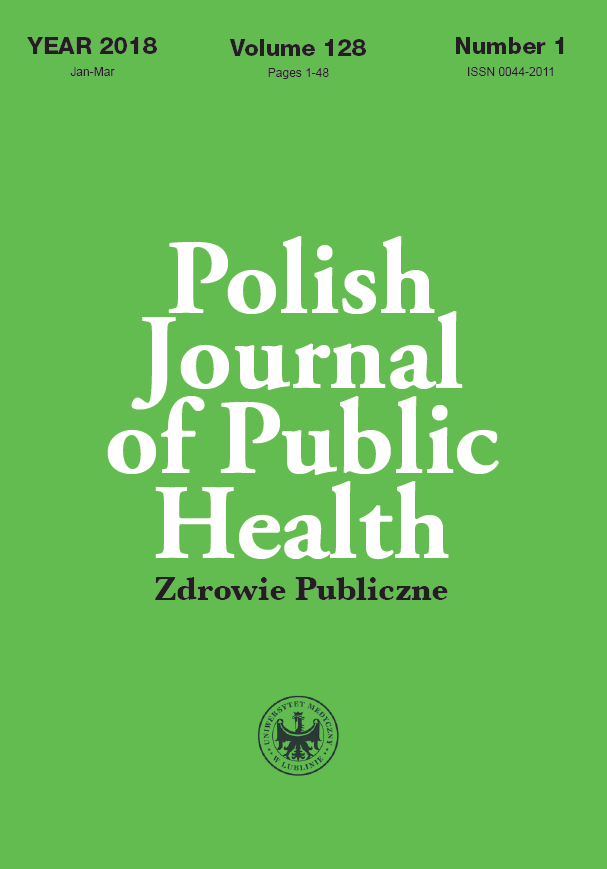Burnout among students of medical universities in Poland
DOI:
https://doi.org/10.2478/pjph-2018-0005Keywords:
burnout among medical students, Copenhagen Burnout Inventory, Polish medical studentsAbstract
Introduction. Burnout among medical students have been thoroughly studied in a number of countries worldwide. Little is known about medical students burnout in the Central European countries.
Material and methods. The study is based on the Copenhagen Burnout Inventory, adapted for measurement of burnout among medical students. The questionnaire contained 6 numerical scale questions about respondents’ satisfaction with studies, university and educational achievements. Students of Polish medical universities were recruited via closed Facebook groups of their faculties. As a result, 778 questionnaires were gathered and analysed. A cluster analysis was performed with the special cluster analysis tool of the Statistica 12 – six questions with numerical scale were used as cluster analysis variables.
Results. Almost 19% of the subjects reported a high or very high total burnout rate – it was almost 40% for both personal and work-related burnout, but less than 5% for patient-related burnout. The cluster analysis revealed three distinctive groups – dissatisfied, middling and satisfied with their studies and university. For both the total and partial scores, the highest burnout was observed among the dissatisfied, the lowest among the satisfied, while the middling group had the average score.
Discussion. A significant level of burnout among Polish medical students, reported in the current study, is consistent with results of numerous investigations performed worldwide. As only 5% of the respondents scored high in patient-related burnout, a question emerges as to whether burnout is more related to clinical subjects or to high learning load.
Conclusions. The current study reveals a significant level of burnout among Polish medical students. Both improved education quality and interesting and innovative teaching methods may possibly prevent high burnout among medical students.
References
1. Definition of BURNOUT. [https://www.merriam-webster.com/dictionary/ burnout] (accessed 22 September 2017).
2. Maslach C, Schaufeli WB, Leiter MP. Job burnout. Annu Rev Psychol. 2001;52:397-422.
3. Fawzy M, Hamed SA. Prevalence of psychological stress, depression and anxiety among medical students in Egypt. Psychiatry Res 2017; 255: 186–194.
4. Moutinho ILD, Maddalena N de CP, Roland RK, et al. Depression, stress and anxiety in medical students: A cross-sectional comparison between students from different semesters. Rev Assoc Medica Bras. 2017;63:21-8.
5. Radcliffe C, Lester H. Perceived stress during undergraduate medical training: a qualitative study. Med Educ. 2003;37:32-8.
6. Dahlin M, Joneborg N, Runeson B. Stress and depression among medical students: a cross-sectional study. Med Educ. 2005;39:594-604.
7. Popa-Velea O, Diaconescu L, Mihăilescu A, et al. Burnout and its relation¬ships with alexithymia, stress, and social support among Romanian medi¬cal students: a cross-sectional study. Int J Environ Res Public Health; 14. Epub ahead of print 25 May 2017. DOI: 10.3390/ijerph14060560.
8. Santen SA, Holt DB, Kemp JD, et al. Burnout in medical students: examin¬ing the prevalence and associated factors. South Med J. 2010;103:758-63.
9. Kristensen TS, Borritz M, Villadsen E, et al. The Copenhagen Burn¬out Inventory: A new tool for the assessment of burnout. Work Stress. 2005;19:192-207.
10. Campos JADB, Carlotto MS, Marôco J. Copenhagen Burnout Inventory – student version: adaptation and transcultural validation for Portugal and Brazil. Psicol Reflex E Crítica. 2013;26:87-97.
11. Almalki SA, Almojali AI, Alothman AS, et al. Burnout and its association with extracurricular activities among medical students in Saudi Arabia. Int J Med Educ. 2017;8:144-50.
12. Fares J, Saadeddin Z, Al Tabosh H, et al. Extracurricular activities associ¬ated with stress and burnout in preclinical medical students. J Epidemiol Glob Health. 2016;6:177-85.
13. Győrffy Z, Birkás E, Sándor I. Career motivation and burnout among medical students in Hungary – could altruism be a protection factor? BMC Med Educ; 16. Epub ahead of print 18 July 2016. DOI: 10.1186/s12909- 016-0690-5.
14. Muzafar Y, Khan HH, Ashraf H, et al. Burnout and its associated factors in medical students of Lahore, Pakistan. Cureus. 2015;7:e390.
15. van Venrooij LT, Barnhoorn PC, Giltay EJ, et al. Burnout, depression and anxiety in preclinical medical students: a cross-sectional survey. Int J Adolesc Med Health; 29. Epub ahead of print 10 November 2015. DOI: 10.1515/ijamh-2015-0077.
16. Dyrbye LN, Massie FS, Eacker A, et al. Relationship between burnout and professional conduct and attitudes among US medical students. JAMA. 2010;304:1173-80.
17. Backović DV, Zivojinović JI, Maksimović J, et al. Gender differences in academic stress and burnout among medical students in final years of edu¬cation. Psychiatr Danub. 2012;24:175-81.
18. Chang E, Eddins-Folensbee F, Coverdale J. Survey of the prevalence of burnout, stress, depression, and the use of supports by medical students at one school. Acad Psychiatry J Am Assoc Dir Psychiatr Resid Train Assoc Acad Psychiatry. 2012;36:177-82.
19. Pagnin D, De Queiroz V, De Oliveira Filho MA, et al. Burnout and career choice motivation in medical students. Med Teach. 2013;35:388-94.
20. Pagnin D, de Queiroz V, Carvalho YTMS, et al. The relation between burnout and sleep disorders in medical students. Acad Psychiatry J Am Assoc Dir Psychiatr Resid Train Assoc Acad Psychiatry. 2014;38:438-444.
21. Wolf MR, Rosenstock JB. Inadequate sleep and exercise associated with burnout and depression among medical students. Acad Psychiatry J Am Assoc Dir Psychiatr Resid Train Assoc Acad Psychiatry. 2017;41:174-9.
22. Aronsson G, Theorell T, Grape T, et al. A systematic review including meta-analysis of work environment and burnout symptoms. BMC Public Health. 2017;17:264.
23. Dyrbye LN, Thomas MR, Massie FS, et al. Burnout and suicidal ideation among U.S. medical students. Ann Intern Med. 2008;149: 334-41.
24. Jackson ER, Shanafelt TD, Hasan O, et al. Burnout and alcohol abuse/ dependence among U.S. medical students. Acad Med J Assoc Am Med Coll. 2016;91:1251-6.
Downloads
Published
Issue
Section
License
Copyright (c) 2018 Polish Journal of Public Health

This work is licensed under a Creative Commons Attribution-NonCommercial-NoDerivatives 3.0 Unported License.


